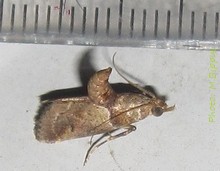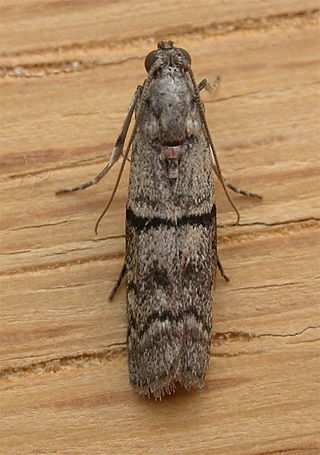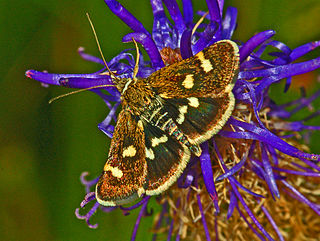| Epimetasia | |
|---|---|
| Scientific classification | |
| Domain: | Eukaryota |
| Kingdom: | Animalia |
| Phylum: | Arthropoda |
| Class: | Insecta |
| Order: | Lepidoptera |
| Family: | Crambidae |
| Tribe: | Odontiini |
| Genus: | Epimetasia Ragonot, 1894 [1] |
| Synonyms | |
| |
| Epimetasia | |
|---|---|
| Scientific classification | |
| Domain: | Eukaryota |
| Kingdom: | Animalia |
| Phylum: | Arthropoda |
| Class: | Insecta |
| Order: | Lepidoptera |
| Family: | Crambidae |
| Tribe: | Odontiini |
| Genus: | Epimetasia Ragonot, 1894 [1] |
| Synonyms | |
| |

Pyraustinae is a large subfamily of the lepidopteran family Crambidae, the crambid snout moths. It currently includes about 1,280 species Most of them tropical but some found in temperate regions including both North America and Europe.

The Pyralinae are the typical subfamily of snout moths and occur essentially worldwide, in some cases aided by involuntary introduction by humans. They are rather rare in the Americas however, and their diversity in the Australian region is also limited. Altogether, this subfamily includes about 900 described species, but new ones continue to be discovered. Like many of their relatives in the superfamily Pyraloidea, the caterpillar larvae of many Pyralinae – and in some cases even the adults – have evolved the ability to use unusual foods for nutrition; a few of these can become harmful to humans as pests of stored goods.

Crambinae is a large subfamily of the lepidopteran family Crambidae, the crambid snout moths. It currently includes over 1,800 species worldwide. The larvae are root feeders or stem borers, mostly on grasses. A few species are pests of sod grasses, maize, sugar cane, rice, and other Poaceae. The monophyly of this group is supported by the structure of the tympanal organs and the phallus attached medially to the juxta, as well as genetic analyses.

Acrobasis is a genus of moths of the family Pyralidae.
Mecyna is a genus of moths of the family Crambidae. The genus was first described by Henry Doubleday in 1849.

Metasia is a genus of moths of the family Crambidae. They are found mainly in Europe and Australia, but also in Africa, Asia, North America, and Pacific islands.

Hypotia is a genus of moths of the family Pyralidae described by Philipp Christoph Zeller in 1847.

The Chrysauginae are a subfamily of snout moths. They are primarily Neotropical and include about 400 described species.
Ancylosis is a genus of snout moth. It was described by Philipp Christoph Zeller in 1839, and is known from South Africa, Uzbekistan, Spain, Turkmenistan, Lebanon, Algeria, Tunisia, Russia, Israel, Palestine, Tinos, Australia, Seychelles, Afghanistan, the United States, Iraq, Namibia, Kazakhstan, Iran, Mauritius, Mozambique, Sarepta, Argentina, Sri Lanka, and Aden.
Epischnia is a genus of moths of the family Pyralidae described by Jacob Hübner in 1825.

The Phycitini are a tribe of moths of the family Pyralidae.
The Anerastiini are a tribe of moths of the family Pyralidae.
Ocrisiodes is a genus of snout moths described by Hans Georg Amsel in 1950.

Odontiinae is a subfamily of moths of the family Crambidae. The subfamily was described by Achille Guenée in 1854.
Epimetasia gregori is a moth in the family Crambidae. It was described by Hans Georg Amsel in 1970. It is found in Afghanistan.
Epimetasia monotona is a moth in the family Crambidae. It was described by Hans Georg Amsel in 1953. It is found in Mauritania.
Epimetasia rhodobaphialis is a moth in the family Crambidae. It was described by Ragonot in 1894. It is found in Uzbekistan.
Epimetasia vestalis is a moth in the family Crambidae. It was described by Ragonot in 1894 and is found in Turkey and Iran.